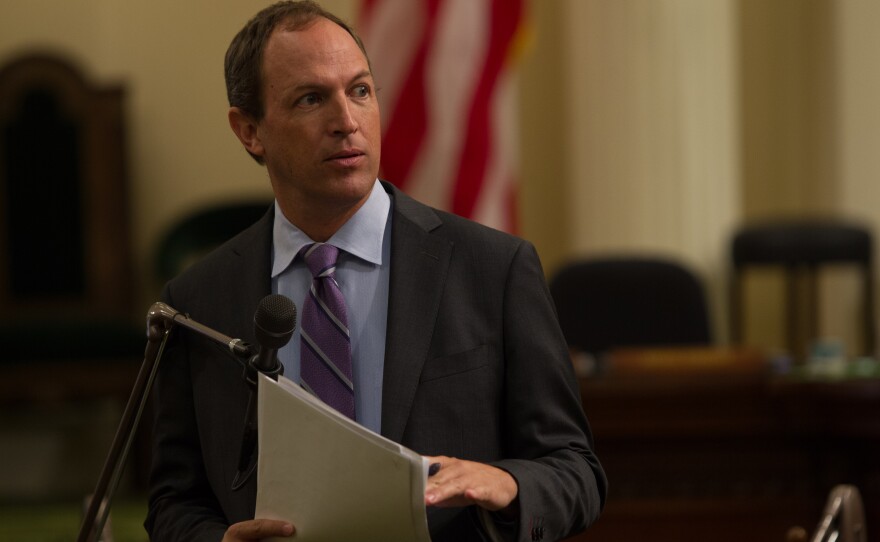KPBS set up a listening post to record some of the most powerful and poignant memories people have of the 2007 firestorm.
Here are excerpts from those memories that were shared:

Assemblyman Brian Maienschien was a San Diego City Council member in 2007. After the fires, he said he quickly assembled a one-stop shop at the Rancho Bernardo Community Center for residents affected by the fires. Each organization involved in the rebuilding process had a table at the center. Maienschien said the one-stop shop helped get the rebuilding done faster and helped the community come together to heal.
"It was really emotional, I mean it was really emotional. People I had grown up with, people that I was a city council member representing them and just to see the emotion of them having lost their home and just all of their possessions, day after day, coming in that one-stop shop. And I set my table up right in the front so when they came in I could help kind of guide them and just that emotion day in and day out, you know really affected me not just professionally obviously but really just personally. I became so close with some of the families and the individuals that went through that and that's something that stuck with me. You know, here we are 10 years later and in some sense I remember it like it was yesterday."

Robin Kaufman is a longtime Rancho Bernardo resident and is the president of the Rancho Bernardo Community Council. She was also the president of the council and a member of the Community Emergency Response Team when the Witch Creek fire burned 365 homes in the community.
"My personal goal is to educate as many people as possible to be prepared, even those that have been through the fires if I go up to them and say 'do you have at least a half tank of gas,' 'do you have your grab-and-go bag,' 'do you have multiple grab and go bags,' 'do you have small bills in the house,' 'do you have, you know, emergency food,' 'do you have water for at least a week, for at least two days,' and they look at me and say 'no' and it saddens me that so many people are not prepared in the event something happens again."

Pete Beauregard evacuated from his Ramona home when the 2007 wildfires approached. It took a while for him to find out whether or not his home survived.
"Finally I called a guy that was digging a well for me up here and he looked and he said 'the house is down to the dirt completely' so that's the way it was, so we went from there, we got some outstanding architects, people that want to build with the land, so we decided to really extend it and build a home that would not burn down, that was our intention, can't you know say its going to be 100 percent fireproof."
He rebuilt in the same spot. Beauregard said the home was rebuilt with fire resistant materials such as a cement fiber siding and a steel roof. It also has fireproof attic vents and bulletproof windows.

"Now if I hear there's fires anywhere around I start to mentally start packing and you know I just live in a way that we keep things together, we keep extra water, like things like our photograph albums or things that you couldn't replace, but I did learn most of all that most everything is replaceable, though I feel very sorry of course to the people who lost family heirlooms, pets, photo albums, the things that give life, you know, texture."
Canfield is president of the Rancho Bernardo Historical Society. An exhibit commemorating the Oct. 2007 firestorm is currently on display at the historical society.

Ross Rizzo did not evacuate. He stayed behind to protect his family business, the Bernardo Winery. Rizzo is now the president and winemaker of the 128 year-old winery.
"It was my father, myself and a couple of maintenance guys and you know we did everything we really could to prepare to put out fires. And throughout the morning and throughout that entire day, the first day of the fires, we went around and we put out spot fires around the property, so what we learned really was how to be better prepared for that."
The winery did not burn and only a few trees were burned on the 13-acre property.

"I learned that that things you have are not that important, that what really helps is the memories... It's memories that you have and in the end that is what life is."

Susheel Dharia also lost his home in the Witch Creek Fire.
"So one of the things I learned was I don't control anything but my attitude. For example just before the fires in 2006 I lost my wife, and then I lost the house so what I realized was I was at the best place I could be for rebuilding. There was nothing but upside for me. So bad things happen but then there is always a positive thing. So that's the second thing I learned, and as a result of that if I look at my life now I have two kids, they are fully settled, have grandkids. I met Nanda in 2012, now we are married. So life moves on, doesn't wait, so that's what I learned from wildfires — just keep the attitude up and keep on going."
This is KPBS Midday Edition. I'm Maureen Cavanaugh today we wrap up our weeklong remembrance of the firestorm that devastated San Diego 10 years ago and a reminder that in San Diego and California we are living with wildfires. Our special bar Cassidy is live from Rancho Bernardo and Ariel -- area hit hard by the wildfires. It was a scene of fear 10 years ago as the Witch Creek Fire moved closer. Recently we brought microphones and cameras appear to record some of the most powerful memories people have from the firestorm. We call it the KPBS listening post. Nancy evacuated with her husband, daughter in two grandchildren. They spent three days at Qualcomm Stadium where another 15,000 people had also sought refuge.Now I hear there's -- now when I hear there's fires around I mentally start packing. I live in a way that will keep things together. We keep extra water and our photograph albums and things that you cannot replace. I did learn that most everything is replaceable. I feel very sorry for people that lost photo albums and pets and family heirlooms.Unlike her Ross did not evacuate. He stood behind to protect the winery.It was my father myself and a couple of Army is guys. We did everything we did to put out fires throughout the morning and throughout the day we went around and put out spot fires on the property so what we learned was how to be very prepared.Only a few trees were burned on the property. That was not the case for Michael Schack. They lost their home in the wildfires.I learned that the things that you have are not that important. What really helps is the memories. It's memories that you have and that is what life is.He also lost his home in the Witch Creek Fire.Something I learned was I don't control anything but my attitude. For example this was before the fires in 2006 I lost my wife and then I lost the house. So when I realize was there was nothing but upside for me. So things happen but there's always something positive. As a result of that I have two kids and they are settled. I have grandkids and in 2012 my son married. That's right learned from that. Just keep the attitude up and keep on going.Those are some of the memories of the 2007 wildfires we heard at the listening post.







